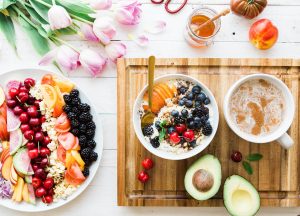When we plan to start eating healthier, we often make too many changes at once. But this often turns out too difficult and your good intentions go down the bin, along with it your motivation. You might even give up. The trick is to change one little thing at a time. And after a few weeks one more little thing. And then maybe one more little thing. And then one day you’ll suddenly think: ‘Wait, I did it!’ With this step-by-step plan you’re off to a great start to eat healthier.

Eating healthier step 1: keep track of your diet for two days
Eating healthier starts with gaining more insight into your eating pattern. You can do this by keeping track of your nutrition for two days: one working day and one weekend day. Try an app to track your food, for example MyFitnessPal, Don’t forget to fill in items such as butter, oil and drinks (possibly with sugar). Stay tuned for step two after finding out what you need during the day in terms of food and drink.
Everyone has different needs
Everyone has different needs when it comes to food and drink. Below I’ve listed everything you need in order to have a healthy body. These are the guidelines that we use in the Netherlands. It may be different in your country (check these links for guidelines in the UK and the US).
The items below are just a guideline. Take a look at your life as a whole as well. For example, do you have a physically demanding job or do you exercise a lot? Then you’ll probably notice that you need more than the guideline during the day. In that case, just eat more. Do you hardly move during the day? Then your energy needs are also low and you therefore need less.
What to eat everyday
In all cases, it is useful to know what food and drink you need to keep your body healthy:
- 250 grams of vegetables: have tomatoes, radishes or cucumber for lunch, for example, and with your hot meal fill half your plate with vegetables.
- 2 portions of fruit: these can also be two of the same types of fruit! Try to vary when you can, this way you get enough of the different nutrients. But eating the same fruit twice in one day is no problem at all, even if these are bananas.
- At least 90 grams (= 3 slices) whole wheat bread. The number varies depending on your gender and, for example, how active you are. See what works for you to maintain your weight and meet your needs. With at least 3 slices (more is also allowed!) you know that you are getting enough of the vitamins and minerals (particularly (in the Netherlands) iodine) in bread.
- Whole grain products, such as whole wheat pasta, brown rice, whole wheat couscous, whole wheat noodles, whole wheat wraps, or 4-5 potatoes. Again, the amounts vary depending on your gender and how active you are. See what works for you to maintain your weight and meet your needs.
- 100 grams of fish OR 100-150 grams of legumes OR 100 grams of meat. If you don’t eat meat, choose for example: fish 1 day a week, legumes 2 days, some extra nuts on 2 days (in addition to your daily portion) and 3-4 eggs per week. If you do not eat fish, you can replace it with, for example, an extra day of legumes. If you’re vegan, don’t forget to take a vitamin B12 supplement.
- 25 grams of unsalted nuts (about a handful).
- 2-3 portions of dairy (a bowl of yoghurt is about 150 ml).
- 40 grams of cheese
- 40 grams of margarine and cooking fats (such as margarine or low-fat margarine on bread and a tablespoon of liquid cooking fat per person for preparing a hot meal).
- 1.5-2 liters of fluid, such as water and tea/coffee without sugar.

Estimate what quantities suit you
As I said, not everyone needs the same amounts. Check how much you need (this may vary per day) and vary with different types of vegetables, fruit, grains, dairy, etc.
Don’t be afraid to eat too many healthy things, this won’t make your weight go up suddenly. Listen to your body and stop when you feel satiated.
Eating healthier step 2: which tiny thing can you change first?
Take your completed food diary. Scroll to the foods above and find out what you could change to eat healthier. Write this down. It may also be more than one thing.
What first tiny step can you take to change this? This step should be small enough so you can do it easily or almost unnoticeably. Choose something that you think will benefit you most.
A few examples of tiny changes
- Do you often eat granola with your yogurt? Granola can contain a lot of sugar, so I can imagine that this could make a difference in your diet. Take one scoop less for a week. That doesn’t seem like much, but we’re taking tiny steps here.
- Do you often eat white bread? Then replace one of your meals of the day with whole wheat bread and do that for a week. Or set a slightly bigger goal and replace all white bread with whole wheat bread for a week. See what works for you.
- Do you drink a lot of soft drinks? Then try diet soda for a week. If you can keep that up, you can work towards replacing it with water. Soft drinks cause more cravings for sweet snacks and although that doesn’t have to be a problem, it can cause you to unintentionally snack more.
- Do you take seconds (or thirds) with your main meal? See if you can make do with half.
- Do you often eat unhealthy snacks in the evening? See if you can replace one product with something healthy and stick with it for a week. Also listen to your hunger: do you really need food now? Or something else?
If these steps still prove to be too big, take even smaller steps. Make them tiny. It must be feasible for you.
Eating healthier step 3: check you calendar
When eating healthier, also take your calendar into account, so that you can fit the above step in properly. What does your week look like in terms of work? And hobbies? Possibly dropping off and picking up children? Business and private appointments?
When do you have enough time to think about the groceries, to do the shopping so you can also buy your new healthy product, to go over recipes (if you like doing this), and to cook? When can you cook meals ahead in time? What do you need for all this? How do you divide these tasks?
Write down the things you need to eat healthier, put them on your shopping list and make a planning.

Eating healthier step 4: make snacks part of your diet
Snacks are part of a healthy diet. If you’ve been craving crisps for days and you’re always strict with yourself, thinking ‘I really can’t eat crisps, I’ll put on weight, they’re off limits’ etc., then at some point you’re going give in anyway (because no one can go their entire life without crisps, and why should you), and then you’ll probably eat much more than you intended when you first started craving them. So, just give in to your craving for something tasty every now and then.
Healthy eating = also snacking occasionally
There is no ‘perfect’ diet, only the one that suits you. And even that changes from time to time. Perfect really doesn’t exist! Only in your head, and we really shouldn’t take every thought we have so seriously. (Seriously.)
You can thoroughly enjoy a spoonful of peanut butter straight from the jar, and you can eat the same breakfast every morning (I personally don’t find this boring! #granolajunkie). Fries and a burger every now and then are delicious, and ice cream when you’re not hungry but want to enjoy it with your family on a day out is absolutely fine!
If you allow yourself to eat crisps whenever you want (or fill in your own fav food), strangely enough, you don’t always want to eat it
Try to separate snacks or ‘unhealthy’ food from your weight and self-image. It’s about listening to your hunger and satiety signals and not depriving yourself of anything. Then you’ll notice that you don’t always want chocolate or crisps. Maybe at first, yes, because you’ve been depriving yourself of them and now you’ll want to eat them like you’re gasping for air when you’ve held your breath for too long. But this will diminish and after a while you won’t see your craving as a guilty pleasure, but just as food that you can enjoy every now and then. Your body won’t crave it so much anymore.
You also don’t have to schedule your snacks. After all, your needs are different every day and it is important to listen to your needs. Plus: suppose it’s your regular snack night, you’re all comfy in front of the TV (Netflix, blanket, pot of tea, bag of M&M’s) and you realise you’re not really hungry at all. Then it would be a shame if you end up eating everything but don’t really enjoy it, right?

Tiny step-by-step plan (in a step-by-step plan): when to eat snacks
So try to listen to your body’s cues really carefully to find out what exactly you need. Eat ‘unhealthy’ snacks when you yourself and only you want them, and don’t eat them just because they’re there, because they were was on sale, or because someone else is eating them.
This step-by-step can help you in moments like this:
- Feel what you need: something nutritious that will keep you going for a while? A light meal? Or do you want to enjoy a sugary snack?
- Imagine for a moment that you would eat what you thought of in step 1. What does it smell like? How does it look? How does it taste on your tongue? How does its texture feel in your mouth?
- Choose something and enjoy it. Choose something you really like. A handy guideline could be to only eat something that you would grade an 8 or higher.

Takeaway
With the above four steps you’ll make a great start to eating healthier. Try changing one tiny thing for a week, and if that goes well (for example, you replaced your afternoon snack with fruit), try a new thing (for example, you eat half as many crisps in the evening, or you replace fruit juice with water or tea). Keep this up for a while and then evaluate whether you’ve achieved your goal. You can read more about successfully learning a new habit here.
As a bonus, these tips can help you eat healthier
- Make sure that everything you eat is tasty! Before you eat it, think about whether you really want it. And remember that nutritious food can also be very tasty.
- Find out what suits you: are you vegetarian or vegan? Or do you eat everything? Do you like typical Dutch or Italian or Asian food? Or everything? There are many options, the most important thing is to find out what suits you when it suits you.
- Last but not least: make sure you can maintain this eating pattern forever. I don’t mean that you should always eat the same thing, but that you should not drastically change your eating habits, because you won’t be able to keep that up. But repacing chocolate spread with peanut butter is a much smaller change and more sustainable (and tasty!).
Best wishes,
Femke



